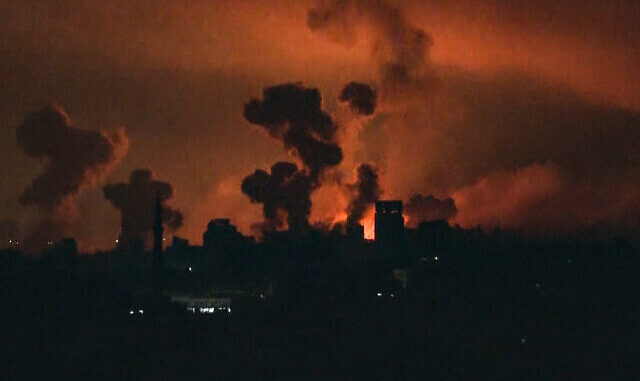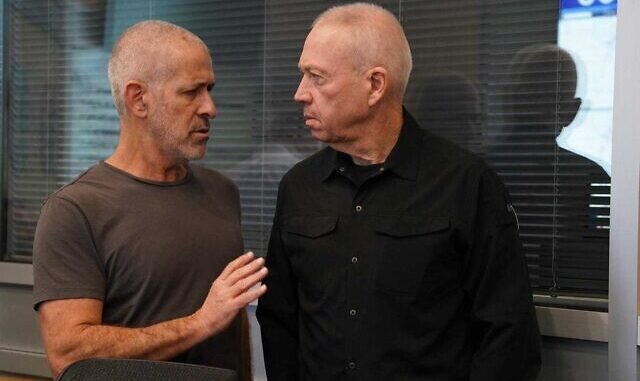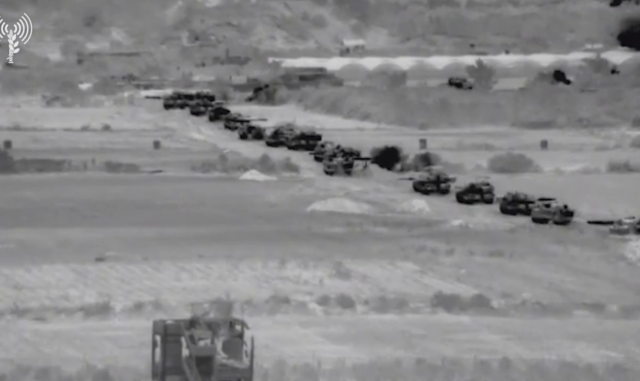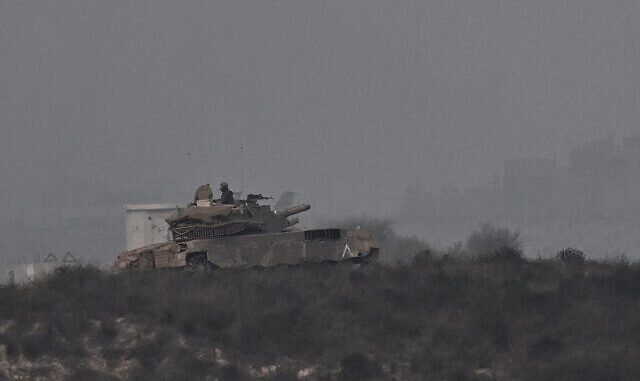IDF says it killed several terrorists including head of Hamas aerial forces; stepped-up ground forces incursion continues; no Israeli injuries in clashes
By EMANUEL FABIAN Today, 10:47 amUpdated at 4:24 pm

This image grab from an AFP TV footage shows fire and smoke rising above Gaza City during an Israeli strike late on October 27, 2023. (Yousef Hassouna/AFP)
Israeli warplanes pounded northern Gaza overnight Friday and on into Saturday, hitting more than 150 underground tunnels and bunkers of the Hamas terror group as tanks and other forces pushed into the Strip in a limited but protracted incursion, the military said.
Defense Minister Yoav Gallant said Saturday afternoon that the war had “entered a new phase,” underlining the stepped-up ground force activity inside Gaza.
Overnight, he said, “the ground shook in Gaza. We attacked above ground and below ground, attacking terrorists of all ranks, in all places.” The war would continue “until further notice,” he added.
Explosions from continuous airstrikes lit up the sky over Gaza City for hours after nightfall Friday. The Israel Defense Forces said a number of Hamas terrorists had been killed in the airstrikes and in several clashes with troops inside Gaza.
Among those killed was the head of Hamas’s so-called aerial array Issam Abu Rukbeh.
A statement from the IDF and Shin Bet intelligence service said that Abu Rukbeh was responsible for managing the terror group’s drones, unmanned aerial vehicles, paragliders, aerial detection systems and air defenses.

In this handout photo, Defense Minister Yoav Gallant (R) speaks with Shin Bet chief Ronen Bar on October 28, 2023, amid the ongoing Israel-Hamas war. (Ariel Hermoni/Defense Ministry)
The military said that he played a role in the planning and execution of the October 7 onslaught by Hamas by directing the terrorists who entered southern Israel on paragliders, as well as the drone attacks on IDF observation posts.
It also said it killed the commander of Hamas’s naval forces of the Gaza City Brigade, Rateb Abu Sahiban, in an overnight airstrike.
The IDF said Abu Sahiban planned and commanded a Hamas infiltration attempt via the sea on October 24th, which was foiled by Israeli Navy forces.
There were no reports of Israeli casualties and the ground forces, including infantry, combat engineering forces and tanks, remained inside Gaza on Saturday morning, operating deeper into the Hamas-run territory than previous limited incursions.
Hamas said it had thwarted Israel’s overnight ground incursion, saying it had used anti-tank Kornet rockets and mortar shelling to repel the attack and claimed to have inflicted casualties among Israeli troops. The terror group did not provide evidence.
The IDF released footage of the ground forces operating in the Gaza Strip overnight and Saturday morning.
The military said it would soon hold assessments as to what the next stages will be, either expanding ground operations further, pausing the ongoing raid, or changing to another set of plans.
Also Saturday, the army said it would start allowing significantly more humanitarian aid to enter the southern Gaza Strip from Egypt.
The IDF hopes that the additional food, water and medical supplies will encourage more Palestinians to leave the northern part of the Gaza Strip for the south.

A still from video released by the IDF shows Israeli tanks rolling into Gaza on October 28, 2023. (Screen capture: IDF)<
Israel has repeatedly warned that it is heavily targeting Gaza City and other areas in northern Gaza, where Hamas is believed to have its main bases of operations and has extensive underground installations, many of them located under the city. The IDF says it will not allow fuel into the Gaza Strip, as it says it is used by Hamas to manage the fighting against Israel.
Palestinian reports from Gaza were scarce after internet and phone services collapsed amid the Israeli bombardment, creating a near-blackout of information, largely cutting off Gaza from contact with the outside world.
The Palestinian telecom provider, Paltel, said the bombardment caused “complete disruption” of internet, cellular and landline services. The cutoff meant that casualties from strikes and details of ground incursions could not immediately be known. Some satellite phones continued to function.
In one of the few reports to emerge from Gaza on Saturday, a reporter for the BBC said there was “total chaos” in the Strip.
“There was a huge bombardment in the north of Gaza Strip on a scale we’ve never seen before,” wrote Rushdi Abualouf. “At the hospital here, ambulance drivers told me they couldn’t communicate with anyone, so they were just driving in the direction of the explosions.”
“Hundreds of buildings and houses were completely destroyed and thousands of other homes were damaged,” Mahmud Bassal, a spokesman for the Hamas-run Gaza Civil Defence told AFP, saying that the intense bombardments had “changed the landscape” of northern Gaza.
Witnesses said most of the bombing was concentrated in areas around two hospitals — Al-Shifa and the so-called Indonesian hospital — located in the Jabaliya district of northern Gaza.<
The strikes left wide craters in the streets and flattened many buildings in the area.
The Israeli military on Friday night revealed that Hamas was using Gaza City’s Shifa Hospital as a main base of operations, providing visuals and intercepted audio as evidence of the terror organization’s activities.
Hagari said Israel has intelligence that there are several tunnels leading to the underground base from outside the hospital so that Hamas officials do not need to enter the hospital to reach it. But Hagari added that there is also an entrance to the underground complex from within one of the wards.
Hagari also said Israel has “concrete evidence” that “hundreds of terrorists flooded into the hospital to hide” following the October 7 terror onslaught.
Hamas’s internal security also has a command center inside Shifa Hospital, from which it directs rocket fire on Israel and stores weapons, he added.
Israel ramped up airstrikes in the Gaza Strip on Friday night and said it was expanding ground operations into the coastal enclave following several nights of limited raids.
“The Air Force is striking underground targets very significantly,” said IDF Spokesman Rear Adm. Daniel Hagari.<
“In addition to the attacks that we carried out in recent days, ground forces are expanding their activity this evening. The IDF is acting with great force… to achieve the objectives of the war.”
For the last two days, IDF infantry forces and tanks have conducted limited operations in the Gaza Strip.
Hagari said the IDF will continue to strike Gaza City and surrounding areas in northern Gaza, and renewed his call for Palestinians to evacuate to the Strip’s south.
“We are prepared to defend in all arenas. We are acting in order to protect the security interests of the State of Israel,” he said.
The Hamas terror group’s military wing, the Izz ad-Din al-Qassam Brigades, said it was confronting Israeli forces in Gaza and that “violent clashes” were taking place near Beit Hanoun in the northern part of the Palestinian enclave, and Bureij in the center.<
US and Israeli officials told ABC News that the Israeli ground incursion in Gaza was not the expected large-scale offensive Israel has been threatening for three weeks — aimed to dismantle Hamas following its devastating October 7 onslaught into Israel. On that Saturday morning, some 2,500 terrorists streamed into Israel by land, sea and air, killing over 1,400 people, a majority of them civilians in their homes and at an outdoor music festival in border communities across southern Israel. Hamas and allied terrorist factions also dragged over 230 hostages — including some 30 children — into the Gaza Strip where they remain captive.
An unnamed American source told ABC that the operation Friday was another limited one. And IDF spokesman Peter Lerner said the activity was not the major operation that has been expected since the devastating terror assault.
On Friday night, White House National Security spokesman John Kirby repeatedly refused to comment on the expanded activities, and said Washington would not draw “red lines” for Israel.
“We’re not drawing red lines for Israel,” Kirby said Friday on a call with reporters. “We’re going to continue to support them” but “since the very beginning we have, and will continue to have, conversations about the manner that they are doing this.”
Defense Minister Yoav Gallant told a small group of foreign reporters earlier that Israel expects a long and difficult ground offensive into Gaza soon. It “will take a long time” to dismantle Hamas’s vast network of tunnels, he said, adding that he expected a lengthy phase of lower-intensity fighting as Israel destroys “pockets of resistance.”
Hamas had earlier called on world countries to “act immediately” to stop Israel’s response to its October 7 massacre.
Israel has vowed to destroy the Palestinian terror organization while minimizing harm to Gaza civilians.

A picture taken from near the southern Israeli city of Sderot on October 28, 2023, shows an Israeli Merkava tank rolling close to the Israeli border with the northern Gaza Strip. (Aris Messinis/AFP)<
On Friday evening, terrorists in Gaza launched a series of rocket barrages into Israel, targeting southern and central Israeli cities. A foreign worker was moderately wounded after a rocket landed in agricultural land near Rishon Lezion, according to medics.
In Sderot, a pair of rockets fired from Gaza slammed into a home and an outdoor shelter. Some damage was caused but no one was harmed.
Gazan terrorists have launched thousands of rockets at Israel since October 7, killing and wounding dozens, and sending hundreds of thousands running for shelter, and the education of hundreds of thousands of children disrupted as schools remain shut or in a limited format.
The IDF has for several weeks been preparing a full-scale incursion aimed at rooting out the Gaza-ruling terror group following its murderous October 7 onslaught in southern Israel.
It has pounded the Strip on an unprecedented scale in order to eliminate potential threats to ground troops once the order finally comes. The airstrikes have flattened entire neighborhoods, causing a level of destruction unseen in the last four wars between Israel and Hamas.
Also Friday, the military said that at least 233 hostages were kidnapped and taken to the Gaza Strip during the devastating assault on October 7.
Hagari said the military has notified the families of 229 hostages that their loved ones are currently being held in the enclave.
The number does not include four released hostages — mother and daughter Judith and Natalie Ra’anan, who were freed a week ago, and elderly women Yocheved Lifshitz and Nurit Cooper, freed on Monday night.
Hagari said the number is not final as the military continues to investigate new information.
However, a member of a Hamas delegation visiting Russia claimed that the terror group still does not know where all the people kidnapped by Palestinian terrorists during their attack are being held.<
The Hamas official, named as Abu Hamid, claimed in an interview with Russia’s semi-official Kommersant news outlet that the terror group has always been willing to release civilians, but “needs time to find them.” He additionally claimed members of various groups are holding hostages, and that a ceasefire was needed to allow Hamas to carry out its search, find the hostages and then release them.
On Wednesday, The New York Times reported that Israel had agreed to a request from the United States to temporarily delay the planned Gaza ground incursion to give Washington more time to deploy additional air defense systems to protect its troops in the region.
The US was also reportedly concerned that Israel lacks achievable military goals for its operations in Gaza, leading to fears that the IDF is not yet ready for a ground incursion.
Gaza’s Hamas-run health ministry says the Israeli strikes have killed over 7,000 people, many of them children. The figures issued by the terror group cannot be independently verified, and are believed to include its own terrorists and gunmen killed in Israel and in Gaza, and the victims of what Israel says are hundreds of errant Palestinian rockets that have landed in the Strip since the war began. Israel says it killed 1,500 Hamas terrorists inside Israel on and after October 7.
Agencies and Times of Israel staff contributed to this report.



MICHAEL-
You must have not read my remark about the editor.
I don’t think I confused anything. I merely criticised the sloppy way it was allowed to be printed. But thank you for pointing it out
Edgar, you may be confusing the caption under the photo with the main part of the article. Also,
A very good report! Go, Jews!
I don’t understand that a Shin Bet leader should direct the Hamas aerial onslaught into Israel.
Whoever the editor is, should have his nose rubbed in it.
“…the army said it would start allowing significantly more humanitarian aid to enter the southern Gaza Strip from Egypt.
The IDF hopes that the additional food, water and medical supplies will encourage more Palestinians to leave the northern part of the Gaza Strip for the south.” Very strange conclusion. Why to leave Gaza if there is “more humanitarian aid” coming? Strange way to conduct the war… The world remembers Berlin, Dresden, Leipzig, Hamburg, Hiroshima, Nagasaki bombed during WWII. Why are the war rules different for Israel? Torah is telling how to fight but Jews are not listening…